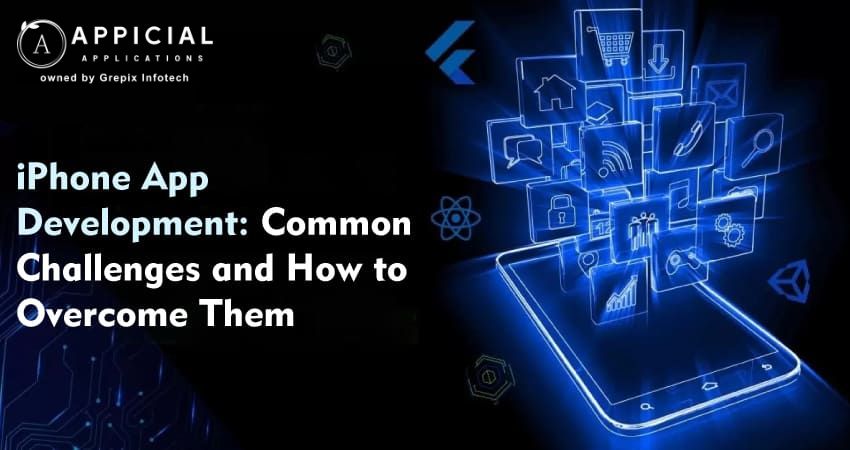
iPhone App Development: Common Challenges and How to Overcome Them
In the fast-paced world of technology, mobile applications have become an integral part of our daily lives, with iPhone apps leading the charge. From social networking to productivity tools, entertainment, and beyond, these apps have revolutionized how we interact with our devices and the world around us. However, developing a successful iPhone app is no small feat. The process is riddled with challenges, from keeping up with the latest iOS updates to ensuring optimal performance and user satisfaction.
For developers, understanding and navigating these challenges is crucial. Each stage of the development process, from conceptualization and design to deployment and post-launch support, brings its own unique set of obstacles. Whether you're a seasoned developer or just starting, being aware of these common challenges and learning how to overcome them can make a significant difference in the success of your app.
In this blog, we will delve into some of the most common challenges faced in iPhone app development and provide practical solutions to tackle them effectively. By the end, you'll have a clearer understanding of the hurdles you may encounter and how to navigate them, setting you on the path to creating high-quality, successful iPhone apps.
iPhone app development presents several challenges, including keeping up with Apple's frequent updates, adhering to design guidelines, handling device fragmentation, optimizing performance, managing memory, ensuring security, navigating the App Store review process, and integrating third-party services. Developers must stay informed, use adaptive layouts, profile and optimize code, embrace Automatic Reference Counting, implement robust security measures, and thoroughly prepare for app submission. Engaging with users and focusing on user-centered design is also crucial. By understanding and addressing these challenges, developers can create high-quality, successful apps that provide a great user experience.
Understanding the iPhone App Development Landscape
Before diving into the challenges, it’s essential to understand the iPhone app development process. It involves several stages: conceptualization, design, development, testing, and deployment. Each stage presents its own set of hurdles that developers need to overcome to ensure a successful app launch.
- User Demographics: Identify the age, gender, location, and interests of your users. This information can help tailor your monetization strategies to better suit their preferences.
- User Behavior: Analyze how users navigate through your app, which features they use the most, and where they spend the most time. Understanding user behavior can highlight opportunities for monetization.
- Feedback and Reviews: Pay attention to user feedback and reviews. Users often provide insights into what they value and are willing to pay for.
Also Read: iPhone App Development vs. Android App Development: Pros and Cons
Challenge 1: Keeping Up with Apple’s Ecosystem
Apple frequently updates its operating system (iOS), introducing new features and deprecating old ones. Keeping up with these changes is critical for developers to ensure their apps remain functional and leverage the latest advancements.
Solution: Regularly Update Your Knowledge
To stay ahead, developers should regularly follow Apple’s updates, attend WWDC (Worldwide Developers Conference) sessions, and participate in developer forums. Continuously updating your skills and knowledge will help you adapt to new changes efficiently.
Challenge 2: Adhering to Apple’s Design Guidelines
Apple is renowned for its stringent design guidelines. While these guidelines ensure a consistent user experience, they can be challenging for developers, especially those new to iOS development.
Solution: Master Apple’s Human Interface Guidelines (HIG)
Invest time in thoroughly understanding Apple’s HIG. Designing your app with these guidelines in mind from the beginning will save time and reduce the risk of rejection during the App Store review process
Challenge 3: Device Fragmentation
Unlike Android, Apple’s device ecosystem is relatively limited. However, developers still need to consider different screen sizes, resolutions, and hardware capabilities across various iPhone models.
Solution: Utilize Adaptive Layouts and Auto Layout
Using Auto Layout in Xcode allows you to create interfaces that adapt to different screen sizes and orientations. Test your app on multiple devices and simulators to ensure a consistent user experience across all models.
Challenge 4: Performance Optimization
Performance issues can significantly impact user experience, leading to poor reviews and uninstallations. Optimizing an app for speed, responsiveness, and battery efficiency is crucial.
Solution: Profile and Optimize Your Code
Use Xcode’s Instruments to profile your app and identify performance bottlenecks. Optimize your code by reducing memory usage, minimizing background tasks, and ensuring efficient use of network resources. Regularly test your app’s performance on real devices to catch and fix issues early.
Challenge 5: Handling Memory Management
Memory management is a critical aspect of iPhone app development. Poor memory management can lead to crashes and a negative user experience.
Solution: Embrace Automatic Reference Counting (ARC)
Apple’s Automatic Reference Counting (ARC) helps manage memory automatically by keeping track of object references. Understand how ARC works and use it to avoid memory leaks and retain cycles. Regularly test your app for memory usage and leaks using Xcode’s Instruments.
Challenge 6: Ensuring Security and Privacy
With increasing concerns about data privacy and security, ensuring your app is secure is paramount. Apple has strict guidelines for app security, and failing to comply can result in rejection from the App Store.
Solution: Implement Robust Security Measures
Incorporate robust security measures such as encryption, secure data storage, and authentication mechanisms. Regularly update your app to address any security vulnerabilities. Be transparent with users about data usage and obtain necessary permissions explicitly.
Challenge 7: Navigating the App Store Review Process
Apple’s App Store review process is known for its strict standards. Navigating this process successfully is a common challenge for developers.
Solution: Thoroughly Prepare Your App for Submission
Ensure your app adheres to all of Apple’s guidelines and requirements before submission. Provide comprehensive metadata, including a detailed description, screenshots, and a clear privacy policy. Address any issues highlighted during the review process promptly and resubmit your app.
Challenge 8: Managing User Expectations and Feedback
Meeting user expectations and managing feedback is crucial for the long-term success of your app. Negative reviews and ratings can impact your app’s visibility and download rates.
Solution: Engage with Your Users
Actively engage with your users by responding to reviews and feedback. Use analytics tools to gather insights into user behavior and preferences. Regularly update your app based on user feedback to improve user satisfaction and retention.
Challenge 9: Integrating Third-Party Services
Integrating third-party services such as APIs, libraries, and SDKs can enhance your app’s functionality. However, these integrations can introduce compatibility issues and dependencies.
Solution: Choose Reliable Third-Party Services
Select reputable third-party services with good documentation and support. Regularly update these services to ensure compatibility with the latest iOS versions. Test your app thoroughly after integrating any third-party components to identify and fix issues early.
Challenge 10: Balancing Innovation and Usability
Innovative features can make your app stand out, but they should not compromise usability. Striking the right balance between innovation and usability is essential for user satisfaction.
Solution: Focus on User-Centered Design
Adopt a user-centered design approach, involving users in the design and testing phases. Conduct usability testing to identify and address any usability issues. Ensure that new features enhance the user experience rather than complicate it.
Conclusion
iPhone app development is a rewarding but challenging endeavor. By understanding and addressing the common challenges discussed in this blog, developers can create high-quality, successful apps. Staying updated with Apple’s ecosystem, adhering to design guidelines, optimizing performance, ensuring security, and engaging with users are key strategies for overcoming these challenges. With careful planning and execution, you can navigate the complexities of iPhone app development and deliver exceptional apps to your users.
In summary, the journey of iPhone app development is filled with hurdles, but each challenge presents an opportunity for growth and innovation. Embrace these challenges, learn from them, and continuously improve your skills and knowledge to thrive in the ever-evolving world of iPhone app development.
Let Appicial Applications be your trusted partner in this journey, as we bring your vision to life and drive your business towards greater heights. Together, we can create exceptional iPhone apps that deliver real value and lasting impact.
Launch your vision with our mobile app development company, where innovation meets excellence to create cutting-edge mobile solutions.





